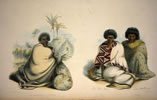Māori had an oral culture. Their introduction to written language began with missionaries teaching them to read and write in Māori. The earliest writings by Māori are by students of Pākehā missionaries. In the 19th century Māori wrote numerous letters – either themselves, or using missionaries or other Māori as scribes.
Māori letters
Letters intended to influence government officials were common. During the northern war against the Crown, Ngāpuhi leader Hōne Heke Pōkai wrote to Governor Robert FitzRoy, asking, ‘What has become of the kind policy of England? Is Her kindness in her cannon, and in her rockets?’1
In 1847, long before he became Māori king, Waikato chief Pōtatau Te Wherowhero sent a letter to Queen Victoria: ‘Madam, listen news is going about here, that your Ministers are talking of taking away the land of the native[s] without cause, which makes our hearts dark.’2 In a famous 1868 letter, Ngā Ruahine chief and war leader Riwha Tītokowaru announced that he was reinstituting cannibalism. He wrote, ‘I shall not die; I shall not die. When death itself is dead I shall be alive.’3 Hundreds of letters by Māori can be found in the Sir Donald McLean papers (in the National Library) and the Grey collection (Auckland Libraries).
Māori-language newspapers
Māori newspapers offered Māori the rare opportunity to publish non-fiction writing in the mid-19th century. Initially letters were written to government-sponsored and -edited Māori-language papers. Following the 1860 conference of chiefs at Kohimarama, a large number of letters were printed in the Maori Messenger – Te Karere Maori from iwi around the country. The letters covered a broad range of topics, including land, the war, sovereignty and the Kīngitanga (Māori King movement).
Māori-owned newspapers
Later letters written to Māori-language newspapers owned and edited by Māori largely reached a Māori audience. Editorials gave Māori perspectives.
Wiremu Pātara Te Tuhi was the editor of Te Hokioi e Rere atu na, a Kīngitanga newspaper. He was able to give the views of the Kīngitanga prior to the outbreak of the war in Waikato. Te Wananga, the newspaper of the Hawke’s Bay-based repudiation movement, was produced under Hēnare Tomoana and Karaitiana Takamoana. They often had bitter exchanges with the government-run paper Te Waka Maori o Niu Tirani.
Ihāia Hūtana was editor of Huia Tangata Kotahi, and Pūrākau Maika oversaw Te Puke ki Hikurangi, both official newspapers of the Kotahitanga parliament. Each gave their political views. Te Whatahoro, editor of Te Tiupiri, often editorialised about the appropriate role and function of the Kotahitanga.













